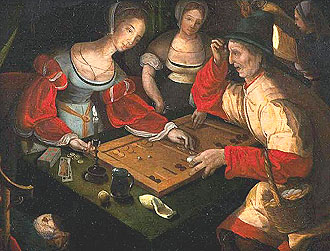|
| Magriel's NYT Columns |
 After taking first prize at the Clermont Club Spring Tournament, Stephen Raphael won the Crockford’s Summer Backgammon Tournament in London this month. These unprecedented back-to-back triumphs were particularly gratifying for Raphael.
After taking first prize at the Clermont Club Spring Tournament, Stephen Raphael won the Crockford’s Summer Backgammon Tournament in London this month. These unprecedented back-to-back triumphs were particularly gratifying for Raphael.
Despite his standing as one of England’s foremost players, first place in international competition had eluded him since before World War II. At Crockford’s, Raphael’s victory over Lou Kollakis in the 25-point match finals was hard fought. The lead changed hands often until Raphael finally nosed ahead, 23 to 22.
The diagrammed position shows a critical turning point in the next and last game. Earlier in the game, Raphael (White) had doubled, Kollakis (Black) accepted and immediately redoubled. With the doubling cube at 4, the winner of this game would reach 25 points and win the match.
|
23
MATCH TO 25 22 |
| Black to play 5-1. |
Black, with three men back, is at a considerable disadvantage. If White escapes with his last man (on Black’s 2-point), White will win the game. Thus Black’s overriding concern now is to contain White’s man. To do this, it is vital for Black to make the bar-point (the 7-point), forming a prime from the 4-point to the 8-point. This would effectively blockade White; in fact, White might well destroy his own home board while trying to bypass the prime.
The correct play is 13/7, boldly slotting the bar-point (leaving a blot exposed there). Black attempts directly to gain possession of this key point. Because White has a strong home board with five points closed, leaving a direct 5-shot may seem unduly risky. However, the probable gain from this play far exceeds the risks.
The gain, if White misses, is evident. Black will be a favorite to cover his blot on the next roll and complete his 5-point prime. In fact, the only realistic way for Black to make the vital bar-point is by slotting; he lacks the builders to make it any other way. Without owning this point, Black will be in repeated jeopardy of White’s escaping.
The risk of Black’s being hit (despite White’s formidable home board) is much less consequential than it first appears. Ordinarily, Black would be concerned about being gammoned. However, with this the final game of the match, a gammon has no relevance. More importantly, if White rolls a 5, Black will not be too much worse off than if he had not slotted. For, whether or not Black slots with a 5, White will come out to Black’s outer board for a probable victory.
In the actual game, Kollakis (Black) played a conservative waiting move, 11/6, 13/12, which minimized his chance of being hit. Raphael (White) then escaped with a 6-5, came home safely, and easily won the game. No matter what play Kollakis made, there was no defense against Raphael’s 6-5; had Kollakis correctly slotted, the result would have been the same. However, if Raphael hadn’t rolled a 5, Kollakis would have been in a better winning position with the correct play.
Slotting is a calculated risk. In this case, by playing decisively Black’s winning chances would be greatly increased. Slotting a key point — however dangerous it may appear — is often the best procedure when:
- Winning without the point is difficult.
- The point is needed urgently.
- Sufficient material is lacking to make the point naturally (without slotting).
Rollout
 Tom Keith 2013 |
|
Match to 25 White 23, Black 22 White owns 4-cube Black rolls 5-1 1296 games with VR Checker play: 2-ply Cube play: 3-ply Red |
| 5-1: | Game | G | BG | Equity | ||||
| 1 | 13/7 |
W L |
.3617 .6383 |
.0328 .4170 |
.0016 .2008 | −0.2765 |

| (a) |
| 2 | 11/6, 8/7 |
W L |
.3441 .6559 |
.0276 .4302 |
.0011 .2109 | −0.3117 | (0.0352) | |
| 3 | 13/12, 11/6 |
W L |
.3337 .6663 |
.0226 .3575 |
.0009 .1399 | −0.3327 | (0.0562) | (b) |
| 4 | 11/5 |
W L |
.3317 .6683 |
.0202 .3727 |
.0010 .1492 | −0.3366 | (0.0601) |

|
|

